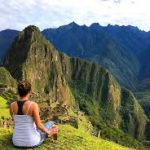Celebrating Caral Raymi this October near Lima
Have you got a little bit of Indiana Jones in you? Travelers and locals alike will flock to the Sacred City of Caral, three hours outside of Lima, as it celebrates its archeological project’s 18th anniversary this month. This project, entrusted with the site’s continuing archeological excavation and conservation, traditionally celebrates the anniversary with pre-Columbian offerings, the unveiling of new findings, and festival events replete with music, dance, exuberant costumes, and fairs.
If you can’t make it to Caral for the anniversary festival, don’t worry, you can still see the site at least. Pirwa Travel Service offers guided tours of the sacred city on the weekends that begin and end in Lima.
Mystical Night (Oct 26)
Those who want to take part in the Mystical Night camp in front of the archeological complex, making a pilgrimage to Gozne Hill along an illuminated route. There, only once a year, they perform ceremonies on the hill, play music and dance, and see the ruins lit up in the night. (If you want to take part, check the archeological project’s website or ask us for assistance at pirwatravel@gmail.com or reservaspirwa@gmail.com. You need to arrange this ahead of time because the event is very popular- thousands take part.)
Caral Raymi Festival (Oct 27)
The Caral Raymi Anniversary Festival lasts from about 9:00am to 4:00pm and falls on October 27th this year. The festivities focus on ancestral Andean music, dance, food and drink. If you go in the afternoon, you can purchase a spot in their traditional lunch prepared with native ingredients by a culinary team guided by the researchers. In the reception center there will be a catu, or Andean market, which functioned through the barter of products and even knowledge.
Take a tour with one of the local guides trained by the team with the aim of improving socio-economic conditions in the surrounding towns. Participate in interactive workshops where you can see the archeologists’ work up close and their latest findings. The day is topped off with a visit to the natural lookout from where you can enjoy panoramic views of the imposing sacred city and the Supe Valley together with the team.
You can get out to Caral by yourself, or with help from the Pirwa Travel Service team. If you would like to take part in one of well-scheduled programs offered by the project itself, you can contact them through their website; they offer one- and two-day programs with transport to and from Lima, all of the activities described, plus some extras such as horseback riding through the Supe Valley and a visit to a contemporaneous site.
Because Caral is 3 hours from Lima, it makes for a little bit of a long day, so it pays to already have a place worked out to spend the night. For budget-friendly dorms and private rooms in Lima’s most popular neighborhood, Miraflores, look to Pirwa Hostels! Pirwa Inclan B&B and Pirwa Prada Backpackers are both located in relaxed Miraflores, close to lively Kennedy Park with its live performers, restaurants and clubs, and the famous costa verde, or “green coast”, the seaside cliffs with its charming parks which acts as a jump-off site for paragliding.
The hostels themselves have common areas where you can relax with other travelers (including TV & Movie lounges, terraces, guest kitchens, and a bar), are secure with 24hr reception and security lockers, and comfortable with soft beds and hot water 24/7.








































